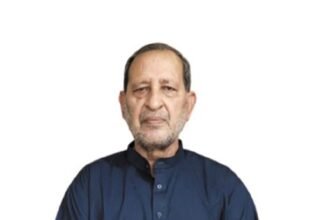Contemporary International
Celebrating the Rebirth of a Literary Giant
The quarterly magazine “Contemporary International” was launched in 1979, a time when Ahmad Nadeem Qasmi was publishing “Funoon” from Lahore, Dr. Wazir Agha was publishing “Auraq” from Sargodha, and Shamsur Rahman Farooqi was running “Shab Khoon” from Allahabad. These magazines dominated the literary scene, attracting a vast readership of Urdu literature both in the subcontinent and around the world. During this period, under the editorship of the esteemed Ata-ul-Haq Qasmi, “Contemporary” began its literary journey, gaining fame far and wide.
From its inception, the magazine enjoyed the literary support of prominent writers such as Muhammad Khalid Akhtar, Ahmad Nadeem Qasmi, Shehzad Ahmed, Mumtaz Mufti, Colonel Muhammad Khan, Ashfaq Ahmed, Bano Qudsia, Intizar Hussain, Anis Naagi, Zameer Jafri, Dr. Saleem Akhtar, Munir Niazi, Ehsan Danish, Jameel Hashmi, Razia Faseeh Ahmed, and Siraj Munir, among many other luminaries. This magazine not only aligned with the demands of the time but was also in line with the impactful creations of its era. For a long time, “Contemporary” was frequently mentioned alongside “Funoon,” “Auraq,” and “Shab Khoon.” However, due to some unavoidable circumstances, this magazine, like many other important literary journals, could not continue its publication. This discontinuation significantly affected Urdu readers spread across the globe. Nowadays, when we start listing literary journals published in Pakistan, we find ourselves pausing after just a few entries.
We do not include literary journals published with government patronage in this list because their criteria differ from those of public magazines, and they primarily publish a specific type of articles. “Mahnoo,” a government publication, has also been in circulation for quite some time. I find myself unable to comment on the limitations and restrictions surrounding government-sponsored publications. In this age of rampant materialism, when media houses and printing presses are facing severe losses, the consistent publication of literary magazines and journals is indeed a significant struggle. When we look around, we notice a severe famine of literary journals. You could call it a drought of both people and publications.
In this intellectual and literary drought, the renewed publication of “Contemporary International” has brought joy to literary circles.
Last week, when I received the latest issue of this important magazine from Mr. Qasmi, my joy knew no bounds. From the selection of articles and creative works to the entire publication process, everything was executed with great care and finesse. Looking at the list of creative works, each piece was distinct and vibrant, which is a hallmark of a magazine published under the aegis of a prominent writer. Among the articles, Ahmed Javed’s piece on Muhammad Saleem Rahman’s imagery is of paramount importance, and even a common reader like me thoroughly enjoyed it.
The articles by Dr. Anwar Ahmed, Hamid Shahid, and Dr. Zia-ul-Hassan drew our attention to several critical aspects of Urdu creation and criticism, especially Dr. Zia’s article, which provided a detailed exploration of the novel’s tradition in Turkey. One of the most significant articles in this issue is by Dr. Nasir Abbas Nayer, titled “Artificial Intelligence versus Human Creation.” This topic has recently come under discussion in conferences and seminars. We urgently need to contemplate where our writers and creators will stand in the rapidly advancing world of artificial intelligence—will their works be read, or will they simply become discarded paper? Dr. Nasir Abbas Nayer’s thought-provoking article on this new and unique topic certainly gave me pause.
In the realm of biography, the sketches of Asghar Nadeem Syed, Munir Niazi, and Ata-ul-Haq Qasmi are outstanding. It’s not possible to discuss each sketch separately, but Asghar Nadeem Syed’s discussion of his relationship with Kamal Ahmed Rizvi and his work was particularly commendable. The issue also includes dedicated sections for Zafar Iqbal, Faisal Ajmi, Nazir Qaiser, and Qamar Raza Shahzad, which serve as tributes from a prominent creator to the people of his era. The inclusion of a personal narrative by our revolutionary writer Wajahat Masood added great pleasure as well. The articles on Ahmad Nadeem Qasmi by Hafiz Khan, on Ghulam Ahmad Parvez by Zafar Supl, and on Literary Sociology by Imran Azfar are also worth reading. The translation section was impressive, especially the translations of Maya Angelou and Geoffrey MacDaniel’s poems by Amberin Haseeb Amber.
Dr. Najib Jamal’s research and critical work on Yagana has always been a topic of discussion, primarily due to its uniqueness. This issue includes an important chapter on Yagana titled “Yagana in Lahore,” which serves as a milestone in the study of Yagana. Poems by more than a dozen poets, including Muhammad Izzhar-ul-Haq, Ali Muhammad Farshi, and Farukh Yaar, as well as ghazals by Sahar Ansari, Khurshid Rizvi, Anwar Shaoor, Hamida Shaheen, and Irfan Siddiqui, further enhance the significance of this issue. I express my gratitude to the associate editors, Mr. Iqtidar Javed and Dr. Ayesha Azeem, for their diligent efforts in preparing this magazine and bringing it to the Urdu readership under the stewardship of Mr. Qasmi.







